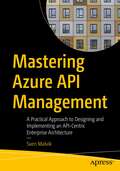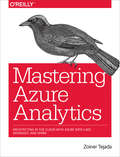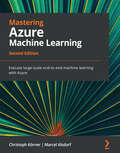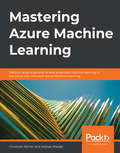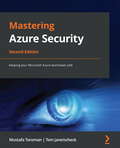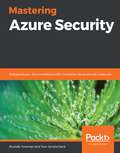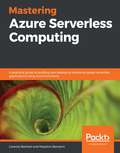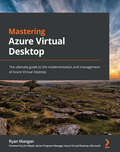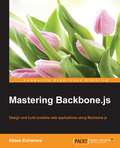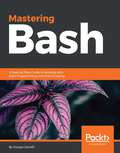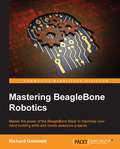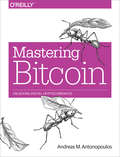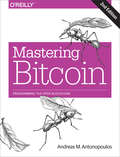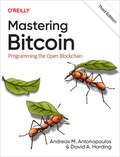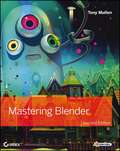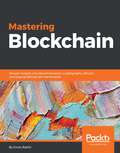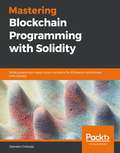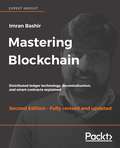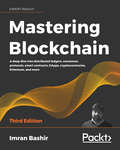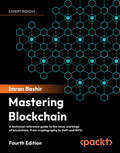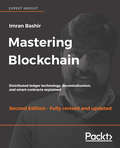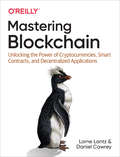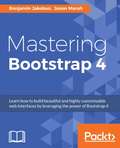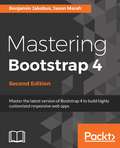- Table View
- List View
Mastering Azure API Management: A Practical Approach to Designing and Implementing an API-Centric Enterprise Architecture
by Sven MalvikUnsure of how or where to get started with Azure API Management, Microsoft’s managed service for securing, maintaining, and monitoring APIs? Then this guide is for you. Azure API Management integrates services like Azure Kubernetes Services (AKS), Function Apps, Logic Apps, and many others with the cloud and provides users with a single, unified, and well-structured façade in the cloud. Mastering Azure API Management is designed to help API developers and cloud engineers learn all aspects of Azure API Management, including security and compliance. It provides a pathway for getting started and learning valuable management and administration skills. You will learn what tools you need to publish a unified API façade towards backend services, independent of where and what they run on. You will begin with an overview of web APIs. You will learn about today’s challenges and how a unified API management approach can help you address them. From there you’ll dive into the key concepts of Azure API Management and be given a practical view and approach of API development in the context of Azure API Management. You'll then review different ways of integrating Azure API Management into your enterprise architecture. From there, you will learn how to optimally maintain and administer Azure API Management to secure your APIs, and learn from them, gaining valuable insights through logging and monitoring. What You Will Learn Discover the benefits of an enterprise API platformUnderstand the basic concepts of API management in the Microsoft cloudDevelop and publish your APIs in the context of Azure API ManagementOnboard users through the developer portalHelp your team or other developers to publish their APIs more efficientlyIntegrate Azure API Management securely into your enterprise architectureManage and maintain to secure your APIs and gain insights Who This Book Is ForAPI developers, cloud engineers, and Microsoft Azure enthusiasts who want to deep dive into managing an API-centric enterprise architecture with Azure API Management. To get the most out of the book, the reader should have a good understanding of micro services and APIs. Basic coding skills, including some experience with PowerShell and Azure, are also beneficial.
Mastering Azure Analytics: Architecting in the Cloud with Azure Data Lake, HDInsight, and Spark
by Zoiner TejadaMicrosoft Azure has over 20 platform-as-a-service (PaaS) offerings that can act in support of a big data analytics solution. So which one is right for your project? This practical book helps you understand the breadth of Azure services by organizing them into a reference framework you can use when crafting your own big data analytics solution.You’ll not only be able to determine which service best fits the job, but also learn how to implement a complete solution that scales, provides human fault tolerance, and supports future needs.Understand the fundamental patterns of the data lake and lambda architectureRecognize the canonical steps in the analytics data pipeline and learn how to use Azure Data Factory to orchestrate themImplement data lakes and lambda architectures, using Azure Data Lake Store, Data Lake Analytics, HDInsight (including Spark), Stream Analytics, SQL Data Warehouse, and Event HubsUnderstand where Azure Machine Learning fits into your analytics pipelineGain experience using these services on real-world data that has real-world problems, with scenarios ranging from aviation to Internet of Things (IoT)
Mastering Azure Machine Learning: Execute large-scale end-to-end machine learning with Azure, 2nd Edition
by Christoph Korner Marcel AlsdorfSupercharge and automate your deployments to Azure Machine Learning clusters and Azure Kubernetes Service using Azure Machine Learning servicesKey FeaturesImplement end-to-end machine learning pipelines on AzureTrain deep learning models using Azure compute infrastructureDeploy machine learning models using MLOpsBook DescriptionAzure Machine Learning is a cloud service for accelerating and managing the machine learning (ML) project life cycle that ML professionals, data scientists, and engineers can use in their day-to-day workflows. This book covers the end-to-end ML process using Microsoft Azure Machine Learning, including data preparation, performing and logging ML training runs, designing training and deployment pipelines, and managing these pipelines via MLOps. The first section shows you how to set up an Azure Machine Learning workspace; ingest and version datasets; as well as preprocess, label, and enrich these datasets for training. In the next two sections, you'll discover how to enrich and train ML models for embedding, classification, and regression. You'll explore advanced NLP techniques, traditional ML models such as boosted trees, modern deep neural networks, recommendation systems, reinforcement learning, and complex distributed ML training techniques - all using Azure Machine Learning. The last section will teach you how to deploy the trained models as a batch pipeline or real-time scoring service using Docker, Azure Machine Learning clusters, Azure Kubernetes Services, and alternative deployment targets. By the end of this book, you'll be able to combine all the steps you've learned by building an MLOps pipeline.What you will learnUnderstand the end-to-end ML pipelineGet to grips with the Azure Machine Learning workspaceIngest, analyze, and preprocess datasets for ML using the Azure cloudTrain traditional and modern ML techniques efficiently using Azure MLDeploy ML models for batch and real-time scoringUnderstand model interoperability with ONNXDeploy ML models to FPGAs and Azure IoT EdgeBuild an automated MLOps pipeline using Azure DevOpsWho this book is forThis book is for machine learning engineers, data scientists, and machine learning developers who want to use the Microsoft Azure cloud to manage their datasets and machine learning experiments and build an enterprise-grade ML architecture using MLOps. This book will also help anyone interested in machine learning to explore important steps of the ML process and use Azure Machine Learning to support them, along with building powerful ML cloud applications. A basic understanding of Python and knowledge of machine learning are recommended.
Mastering Azure Machine Learning: Perform large-scale end-to-end advanced machine learning on the cloud with Microsoft Azure ML
by Christoph Korner Kaijisse WaaijerMaster expert techniques for building automated and highly scalable end-to-end machine learning models and pipelines in Azure using TensorFlow, Spark, and Kubernetes Key Features Make sense of data on the cloud by implementing advanced analytics Train and optimize advanced deep learning models efficiently on Spark using Azure Databricks Deploy machine learning models for batch and real-time scoring with Azure Kubernetes Service (AKS) Book Description The increase being seen in data volume today requires distributed systems, powerful algorithms, and scalable cloud infrastructure to compute insights and train and deploy machine learning (ML) models. This book will help you improve your knowledge of building ML models using Azure and end-to-end ML pipelines on the cloud. The book starts with an overview of an end-to-end ML project and a guide on how to choose the right Azure service for different ML tasks. It then focuses on Azure ML and takes you through the process of data experimentation, data preparation, and feature engineering using Azure ML and Python. You'll learn advanced feature extraction techniques using natural language processing (NLP), classical ML techniques, and the secrets of both a great recommendation engine and a performant computer vision model using deep learning methods. You'll also explore how to train, optimize, and tune models using Azure AutoML and HyperDrive, and perform distributed training on Azure ML. Then, you'll learn different deployment and monitoring techniques using Azure Kubernetes Services with Azure ML, along with the basics of MLOps—DevOps for ML to automate your ML process as CI/CD pipeline. By the end of this book, you'll have mastered Azure ML and be able to confidently design, build and operate scalable ML pipelines in Azure. What you will learn Setup your Azure ML workspace for data experimentation and visualization Perform ETL, data preparation, and feature extraction using Azure best practices Implement advanced feature extraction using NLP and word embeddings Train gradient boosted tree-ensembles, recommendation engines and deep neural networks on Azure ML Use hyperparameter tuning and AutoML to optimize your ML models Employ distributed ML on GPU clusters using Horovod in Azure ML Deploy, operate and manage your ML models at scale Automated your end-to-end ML process as CI/CD pipelines for MLOps Who this book is for This machine learning book is for data professionals, data analysts, data engineers, data scientists, or machine learning developers who want to master scalable cloud-based machine learning architectures in Azure. This book will help you use advanced Azure services to build intelligent machine learning applications. A basic understanding of Python and working knowledge of machine learning are mandatory.
Mastering Azure Security: Keeping your Microsoft Azure workloads safe, 2nd Edition
by Mustafa Toroman Tom JanetscheckGet to grips with artificial intelligence and cybersecurity techniques to respond to adversaries and incidentsKey FeaturesLearn how to secure your Azure cloud workloads across applications and networksProtect your Azure infrastructure from cyber attacksDiscover tips and techniques for implementing, deploying, and maintaining secure cloud services using best practicesBook DescriptionSecurity is integrated into every cloud, but this makes users put their guard down as they take cloud security for granted. Although the cloud provides higher security, keeping their resources secure is one of the biggest challenges many organizations face as threats are constantly evolving. Microsoft Azure offers a shared responsibility model that can address any challenge with the right approach.Revised to cover product updates up to early 2022, this book will help you explore a variety of services and features from Microsoft Azure that can help you overcome challenges in cloud security. You'll start by learning the most important security concepts in Azure, their implementation, and then advance to understanding how to keep resources secure. The book will guide you through the tools available for monitoring Azure security and enforcing security and governance the right way. You'll also explore tools to detect threats before they can do any real damage and those that use machine learning and AI to analyze your security logs and detect anomalies.By the end of this cloud security book, you'll have understood cybersecurity in the cloud and be able to design secure solutions in Microsoft Azure.What you will learnBecome well-versed with cloud security conceptsGet the hang of managing cloud identitiesUnderstand the zero-trust approachAdopt the Azure security cloud infrastructureProtect and encrypt your dataGrasp Azure network security conceptsDiscover how to keep cloud resources secureImplement cloud governance with security policies and rulesWho this book is forThis book is for Azure cloud professionals, Azure architects, and security professionals looking to implement secure cloud services using Azure Security Centre and other Azure security features. A solid understanding of fundamental security concepts and prior exposure to the Azure cloud will help you understand the key concepts covered in the book more effectively.
Mastering Azure Security: Safeguard your Azure workload with innovative cloud security measures
by Mustafa Toroman Tom JanetscheckLeverage Azure security services to architect robust cloud solutions in Microsoft Azure Key Features Secure your Azure cloud workloads across applications and networks Protect your Azure infrastructure from cyber attacks Discover tips and techniques for implementing, deploying, and maintaining secure cloud services using best practices Book Description Security is always integrated into cloud platforms, causing users to let their guard down as they take cloud security for granted.Cloud computing brings new security challenges, but you can overcome these with Microsoft Azure's shared responsibility model. Mastering Azure Security covers the latest security features provided by Microsoft to identify different threats and protect your Azure cloud using innovative techniques. The book takes you through the built-in security controls and the multi-layered security features offered by Azure to protect cloud workloads across apps and networks. You'll get to grips with using Azure Security Center for unified security management, building secure application gateways on Azure, protecting the cloud from DDoS attacks, safeguarding with Azure Key Vault, and much more. Additionally, the book covers Azure Sentinel, monitoring and auditing, Azure security and governance best practices, and securing PaaS deployments. By the end of this book, you'll have developed a solid understanding of cybersecurity in the cloud and be able to design secure solutions in Microsoft Azure. What you will learn Understand cloud security concepts Get to grips with managing cloud identities Adopt the Azure security cloud infrastructure Grasp Azure network security concepts Discover how to keep cloud resources secure Implement cloud governance with security policies and rules Who this book is for This book is for Azure cloud professionals, Azure architects, and security professionals looking to implement secure cloud services using Azure Security Centre and other Azure security features. A fundamental understanding of security concepts and prior exposure to the Azure cloud will help you understand the key concepts covered in the book more effectively.
Mastering Azure Serverless Computing: A practical guide to building and deploying enterprise-grade serverless applications using Azure Functions
by Lorenzo Barbieri Massimo BonanniBecome an expert in implementing Azure Functions to work seamlessly with your serverless applications Key Features Develop scalable, robust multi-tier apps without worrying about infrastructure needs Deploy and manage cost-effective and highly available serverless apps using Azure Functions Accelerate enterprise-level application development by seamlessly integrating different cloud services with Azure Functions Book Description Application development has evolved from traditional monolithic app development to using serverless options and microservices. This book is designed to guide you through using Microsoft's Azure Functions to process data, integrate systems, and build simple APIs and microservices. You will discover how to apply serverless computing to speed up deployment and reduce downtime. You'll also explore Azure Functions, including its core functionalities and essential tools, along with understanding how to debug and even customize Azure Functions. In addition to this, the book will take you through how you can effectively implement DevOps and automation in your working environment. Toward the concluding chapters, you'll cover some quick tips, troubleshooting techniques, and real-world serverless use cases that will help you make the most of serverless computing. By the end of this book, you will have gained the skills you need to develop and deliver cost-effective Azure serverless solutions. What you will learn Create and deploy advanced Azure Functions Learn to extend the runtime of Azure Functions Orchestrate your logic through code or a visual workflow Add caching, security, routing, and filtering to your APIs Use serverless technologies in real-world scenarios Understand how to apply DevOps and automation to your working environment Who this book is for This book is designed for cloud administrators, architects, and developers interested in building scalable systems and deploying serverless applications with Azure Functions. Prior knowledge of core Microsoft Azure services and Azure Functions is necessary to understand the topics covered in this book.
Mastering Azure Virtual Desktop: The ultimate guide to the implementation and management of Azure Virtual Desktop
by Ryan Mangan Jim MoyleLearn how to design, implement, configure, and manage your Azure Virtual Desktop environmentKey FeaturesLearn everything about designing and deploying an Azure Virtual Desktop environmentGain in-depth insights into Azure Virtual Desktop and prepare successfully for the AZ-140 examExplore best practices and expert tips on how to set up Azure Virtual DesktopBook DescriptionAzure Virtual Desktop is a cloud desktop virtualization platform that securely delivers virtual desktops and remote apps. Mastering Azure Virtual Desktop will guide you through designing, implementing, configuring, and maintaining an Azure Virtual Desktop environment effectively. This book can also be used as an exam preparation guide to help you sit the Microsoft AZ-140 exam.You'll start with an introduction to the essentials of Azure Virtual Desktop. Next, you'll get to grips with planning an Azure Virtual Desktop architecture before learning how to implement an Azure Virtual Desktop environment. Moving ahead, you'll learn how to manage and control access as well as configure security controls on your Azure Virtual Desktop environment. As you progress, you'll understand how to manage user environments and configure MSIX app attach and other Azure Virtual Desktop features to enhance the user experience. You'll also learn about the Azure Active Directory (AD) join and getting started feature. Finally, you'll discover how to monitor and maintain an Azure Virtual Desktop environment to help you support your users and diagnose issues when they occur.By the end of this Microsoft Azure book, you'll have covered all the essential topics you need to know to design and manage Azure Virtual Desktop and prepare for the AZ-140 exam.What you will learnDesign Azure Virtual Desktop and user identities and profilesImplement networking and storage for Azure Virtual DesktopCreate and configure session host images and host poolsManage access and security for MS Azure Virtual DesktopImplement FSLogix Profile Containers and FSLogix Cloud CacheConfigure user experience and Azure Virtual Desktop featuresPlan and implement business continuity and disaster recoveryAutomate Azure Virtual Desktop tasksWho this book is forIf you are an IT professional, workspace administrator, architect, or consultant looking to learn about designing, implementing, and managing Azure Virtual Desktop, this book is for you. You'll also find this book helpful if you're preparing for the Microsoft AZ-140 exam.
Mastering Azure Virtual Desktop: The ultimate guide to the implementation and management of Azure Virtual Desktop
by Ryan ManganLearn how to design, implement, configure, and manage your Azure Virtual Desktop environmentKey FeaturesLearn everything about designing and deploying an Azure Virtual Desktop environmentGain in-depth insights into Azure Virtual Desktop and prepare successfully for the AZ-140 examExplore best practices and expert tips on how to set up Azure Virtual DesktopBook DescriptionAzure Virtual Desktop is a cloud desktop virtualization platform that securely delivers virtual desktops and remote apps. Mastering Azure Virtual Desktop will guide you through designing, implementing, configuring, and maintaining an Azure Virtual Desktop environment effectively. This book can also be used as an exam preparation guide to help you sit the Microsoft AZ-140 exam. You’ll start with an introduction to the essentials of Azure Virtual Desktop. Next, you’ll get to grips with planning an Azure Virtual Desktop architecture before learning how to implement an Azure Virtual Desktop environment. Moving ahead, you’ll learn how to manage and control access as well as configure security controls on your Azure Virtual Desktop environment. As you progress, you’ll understand how to manage user environments and configure MSIX app attach and other Azure Virtual Desktop features to enhance the user experience. You’ll also learn about the Azure Active Directory (AD) join and getting started feature. Finally, you’ll discover how to monitor and maintain an Azure Virtual Desktop environment to help you support your users and diagnose issues when they occur. By the end of this Microsoft Azure book, you’ll have covered all the essential topics you need to know to design and manage Azure Virtual Desktop and prepare for the AZ-140 exam.What you will learnDesign Azure Virtual Desktop and user identities and profilesImplement networking and storage for Azure Virtual DesktopCreate and configure session host images and host poolsManage access and security for MS Azure Virtual DesktopImplement FSLogix Profile Containers and FSLogix Cloud CacheConfigure user experience and Azure Virtual Desktop featuresPlan and implement business continuity and disaster recoveryAutomate Azure Virtual Desktop tasksWho this book is forIf you are an IT professional, workspace administrator, architect, or consultant looking to learn about designing, implementing, and managing Azure Virtual Desktop, this book is for you. You’ll also find this book helpful if you’re preparing for the Microsoft AZ-140 exam.
Mastering Backbone.js
by Abiee EchameaDesign and build scalable web applications using Backbone.jsAbout This BookLevel up your Backbone.js skills and create professional web applications with the best practicesUse the Backbone.js components in the right way and avoid maintenance nightmaresImprove your development workflow from application design to deploymentApply the best practices given in this tutorial to solve day-to-day problems in your applicationsWho This Book Is ForThis book is for those developers who know the basic concepts of Backbone.js and want to build scalable applications with it. If you are looking for the best practices of using Backbone.js applied to real work applications, this book is for you. You will be able to apply architectural principles to create amazing web applications easily.What You Will LearnBuild web applications that scale with Backbone.jsDesign a powerful architecture that eliminates maintenance nightmaresUse common patterns and best practices in Backbone.js web applications developmentsPack your applications to be deployed to production environmentsClean up your code organization to a simple and maintainable architectureTest your components and get confidence with your codeDeal with common scenarios like file uploading and login issuesIn DetailBackbone.js is a popular library to build single page applications used by many start-ups around the world because of its flexibility, robustness and simplicity. It allows you to bring your own tools and libraries to make amazing webapps with your own rules. However, due to its flexibility it is not always easy to create scalable applications with it. By learning the best practices and project organization you will be able to create maintainable and scalable web applications with Backbone.js.With this book you will start right from organizing your Backbone.js application to learn where to put each module and how to wire them. From organizing your code in a logical and physical way, you will go on to delimit view responsibilities and work with complex layouts.Synchronizing models in a two-way binding can be difficult and with sub resources attached it can be even worse. The next chapter will explain strategies for how to deal with these models. The following chapters will help you to manage module dependencies on your projects, explore strategies to upload files to a RESTful API and store information directly in the browser for using it with Backbone.js. After testing your application, you are ready to deploy it to your production environment. The final chapter will cover different flavors of authorization.The Backbone.js library can be difficult to master, but in this book you will get the necessary skill set to create applications with it, and you will be able to use any other library you want in your stack.Style and approachThis book takes a tutorial approach to help you scale your Backbone.js applications. It builds a web application using the best practices and applies architectural design principles to develop maintainable web-apps. Each chapter explains the design decisions and improves the project that is used as an example alongside the book.
Mastering Bash
by Giorgio ZarrelliYour one stop guide to making the most out of Bash programming About This Book • From roots to leaves, learn how to program in Bash and automate daily tasks, pouring some spice in your scripts • Daemonize a script and make a real service of it, ensuring it's available at any time to process user-fed data or commands • This book provides functional examples that show you practical applications of commands Who This Book Is For If you're a power user or system administrator involved in writing Bash scripts to automate tasks, then this book is for you. This book is also ideal for advanced users who are engaged in complex daily tasks. What You Will Learn • Understand Bash right from the basics and progress to an advanced level • Customise your environment and automate system routine tasks • Write structured scripts and create a command-line interface for your scripts • Understand arrays, menus, and functions • Securely execute remote commands using ssh • Write Nagios plugins to automate your infrastructure checks • Interact with web services, and a Slack notification script • Find out how to execute subshells and take advantage of parallelism • Explore inter-process communication and write your own daemon In Detail System administration is an everyday effort that involves a lot of tedious tasks, and devious pits. Knowing your environment is the key to unleashing the most powerful solution that will make your life easy as an administrator, and show you the path to new heights. Bash is your Swiss army knife to set up your working or home environment as you want, when you want. This book will enable you to customize your system step by step, making your own real, virtual, home out of it. The journey will take you swiftly through the basis of the shell programming in Bash to more interesting and challenging tasks. You will be introduced to one of the most famous open source monitoring systems—Nagios, and write complex programs with it in any languages. You'll see how to perform checks on your sites and applications. Moving on, you'll discover how to write your own daemons so you can create your services and take advantage of inter-process communication to let your scripts talk to each other. So, despite these being everyday tasks, you'll have a lot of fun on the way. By the end of the book, you will have gained advanced knowledge of Bash that will help you automate routine tasks and manage your systems. Style and approach This book presents step-by-step instructions and expert advice on working with Bash and writing scripts. Starting from the basics, this book serves as a reference manual where you can find handy solutions and advice to make your scripts flexible and powerful.
Mastering BeagleBone Robotics
by Richard GrimmettIf you want a simple guide to building complex robots, then this book is for you. You'll need some programming knowledge and experience working with mechanical systems.
Mastering Bitcoin
by Andreas M. AntonopoulosWant to join the technological revolution that's taking the world of finance by storm? Mastering Bitcoin is your guide through the seemingly complex world of bitcoin, providing the requisite knowledge to help you participate in the internet of money. Whether you're building the next killer app, investing in a startup, or simply curious about the technology, this practical book is essential reading.Bitcoin, the first successful decentralized digital currency, is still in its infancy and it's already spawned a multi-billion dollar global economy. This economy is open to anyone with the knowledge and passion to participate. Mastering Bitcoin provides you with the knowledge you need (passion not included).This book includes:A broad introduction to bitcoin--ideal for non-technical users, investors, and business executivesAn explanation of the technical foundations of bitcoin and cryptographic currencies for developers, engineers, and software and systems architectsDetails of the bitcoin decentralized network, peer-to-peer architecture, transaction lifecycle, and security principlesOffshoots of the bitcoin and blockchain inventions, including alternative chains, currencies, and applicationsUser stories, analogies, examples, and code snippets illustrating key technical concepts
Mastering Bitcoin: Programming the Open Blockchain
by Andreas M. AntonopoulosJoin the technological revolution that’s taking the financial world by storm. Mastering Bitcoin is your guide through the seemingly complex world of bitcoin, providing the knowledge you need to participate in the internet of money. Whether you’re building the next killer app, investing in a startup, or simply curious about the technology, this revised and expanded second edition provides essential detail to get you started.Bitcoin, the first successful decentralized digital currency, is still in its early stages and yet it’s already spawned a multi-billion-dollar global economy open to anyone with the knowledge and passion to participate. Mastering Bitcoin provides the knowledge. You simply supply the passion.The second edition includes:A broad introduction of bitcoin and its underlying blockchain—ideal for non-technical users, investors, and business executivesAn explanation of the technical foundations of bitcoin and cryptographic currencies for developers, engineers, and software and systems architectsDetails of the bitcoin decentralized network, peer-to-peer architecture, transaction lifecycle, and security principlesNew developments such as Segregated Witness, Payment Channels, and Lightning NetworkA deep dive into blockchain applications, including how to combine the building blocks offered by this platform into higher-level applicationsUser stories, analogies, examples, and code snippets illustrating key technical concepts
Mastering Bitcoin: Programming the Open Blockchain
by Andreas M. Antonopoulos David A. HardingJoin the technological revolution that's taking the financial world by storm. Mastering Bitcoin is your guide through the seemingly complex world of Bitcoin, providing the knowledge you need to participate in the internet of money. Whether you're building the next killer app, investing in a startup, or simply curious about the technology, this revised and expanded third edition provides essential detail to get you started. Bitcoin, the first successful decentralized digital currency, has already spawned a multibillion-dollar global economy open to anyone with the knowledge and passion to participate. Mastering Bitcoin provides the knowledge. You supply the passion.The third edition includes:A broad introduction to Bitcoin and its underlying blockchain—ideal for nontechnical users, investors, and business executivesAn explanation of Bitcoin's technical foundation and cryptographic currency for developers, engineers, and software and systems architectsDetails of the Bitcoin decentralized network, peer-to-peer architecture, transaction lifecycle, and security principlesNew developments such as Taproot, Tapscript, Schnorr signatures, and the Lightning NetworkA deep dive into Bitcoin applications, including how to combine the building blocks offered by this platform into powerful new toolsUser stories, analogies, examples, and code snippets illustrating key technical concepts
Mastering Blender
by Tony MullenNew edition shows you how to get the very most out of the latest version of BlenderBlender, the open-source 3D software, is more popular than ever and continues to add functionality. If you're an intermediate or advanced user, this new edition of Tony Mullen's expert guide is what you need to get up to speed on Blender and expand your skills. From modeling, texturing, animation, and visual effects to high-level techniques for film, television, games, and more, this book covers it all. It also highlights Blender's very latest features, including new camera tracking tools and a new renderer.Provides intermediate to advanced coverage of Blender and its modeling, texturing, animation, and visual effects tools Covers advanced topics such as cloth, fur and fluids, Python scripting, and the Blender game engine Brings you up to speed on Blender's new camera tracking tools and new renderer Showcases techniques used in real-world 3D animation and visual effectsCreate realistic animation and visual effects with Blender and this expert guide that shows you step by step how to do it.
Mastering Blockchain
by Imran BashirDistributed ledgers, decentralization and smart contracts explained About This Book • Get to grips with the underlying technical principles and implementations of blockchain. • Build powerful applications using Ethereum to secure transactions and create smart contracts. • Explore cryptography, mine cryptocurrencies, and solve scalability issues with this comprehensive guide. Who This Book Is For This book appeals to those who wish to build fast, highly secure, transactional applications. This book is for those who are familiar with the concept of blockchain and are comfortable with a programming language. What You Will Learn • Master the theoretical and technical foundations of blockchain technology • Fully comprehend the concept of decentralization, its impact and relationship with blockchain technology • Experience how cryptography is used to secure data with practical examples • Grasp the inner workings of blockchain and relevant mechanisms behind Bitcoin and alternative cryptocurrencies • Understand theoretical foundations of smart contracts • Identify and examine applications of blockchain technology outside of currencies • Investigate alternate blockchain solutions including Hyperledger, Corda, and many more • Explore research topics and future scope of blockchain technology In Detail Blockchain is a distributed database that enables permanent, transparent, and secure storage of data. The blockchain technology is the backbone of cryptocurrency – in fact, it's the shared public ledger upon which the entire Bitcoin network relies – and it's gaining popularity with people who work in finance, government, and the arts. Blockhchain technology uses cryptography to keep data secure. This book gives a detailed description of this leading technology and its implementation in the real world. This book begins with the technical foundations of blockchain, teaching you the fundamentals of cryptography and how it keeps data secure. You will learn about the mechanisms behind cryptocurrencies and how to develop applications using Ethereum, a decentralized virtual machine. You will explore different blockchain solutions and get an exclusive preview into Hyperledger, an upcoming blockchain solution from IBM and the Linux Foundation. You will also be shown how to implement blockchain beyond currencies, scability with blockchain, and the future scope of this fascinating and powerful technology. Style and approach This comprehensive guide allows you to build smart blockchain applications and explore the power of this database. The book will let you quickly brush up on the basics of the blockchain database, followed by advanced implementations of blockchain in currency, smart contracts, decentralization, and so on.
Mastering Blockchain Programming with Solidity: Write production-ready smart contracts for Ethereum blockchain with Solidity
by Jitendra ChittodaDiscover the advanced features of Solidity that will help you write high-quality code and develop secure smart contracts with the latest ERC standards Key Features Delve into Solidity and understand control structures, function calls, and variable scopes Explore tools for developing, testing, and debugging your blockchain applications Learn advanced design patterns and best practices for writing secure smart contracts Book Description Solidity is among the most popular and contract-oriented programming languages used for writing decentralized applications (DApps) on Ethereum blockchain. If you're looking to perfect your skills in writing professional-grade smart contracts using Solidity, this book can help. You will get started with a detailed introduction to blockchain, smart contracts, and Ethereum, while also gaining useful insights into the Solidity programming language. A dedicated section will then take you through the different Ethereum Request for Comments (ERC) standards, including ERC-20, ERC-223, and ERC-721, and demonstrate how you can choose among these standards while writing smart contracts. As you approach later chapters, you will cover the different smart contracts available for use in libraries such as OpenZeppelin. You'll also learn to use different open source tools to test, review and improve the quality of your code and make it production-ready. Toward the end of this book, you'll get to grips with techniques such as adding security to smart contracts, and gain insights into various security considerations. By the end of this book, you will have the skills you need to write secure, production-ready smart contracts in Solidity from scratch for decentralized applications on Ethereum blockchain. What you will learn Test and debug smart contracts with Truffle, Ganache, Remix, and MetaMask Gain insights into maintaining code quality with different tools Get up to speed with ERC standards such as ERC-20 and ERC-721 Become adept at using design patterns while writing smart contracts Use MultiSignature (MultiSig) wallets and improve the security of contracts Use Oracle services to fetch information from outside the blockchain Who this book is for This book is for developers and data scientists who want to learn Ethereum, blockchain, and Solidity to write smart contracts and develop production-ready code. Basic knowledge of Solidity is assumed.
Mastering Blockchain, Second Edition: Distributed Ledger Technology, Decentralization, And Smart Contracts Explained, 2nd Edition
by Imran BashirBlockchain is a distributed database that enables permanent, transparent, and secure storage of data. The blockchain technology is the backbone of cryptocurrency and it is gaining popularity with people who work in the finance, government, and arts sectors. This book is an up-to-date, one-stop guide to this leading technology and its implementation in the real world.
Mastering Blockchain: A deep dive into distributed ledgers, consensus protocols, smart contracts, DApps, cryptocurrencies, Ethereum, and more, 3rd Edition
by Imran BashirDevelop a deep understanding of the theoretical foundations of blockchain technology and learn how to write smart contracts and build decentralized applications Key Features Updated with four new chapters on consensus algorithms, Ethereum 2.0, tokenization, and enterprise blockchains Dive deep into foundational pillars of blockchain technology such as decentralization, cryptography, and consensus protocols Get to grips with Solidity, Web3, cryptocurrencies, smart contract development and solve scalability, security, and privacy issues Discover the architecture of different distributed ledger platforms including Ethereum, Bitcoin, Hyperledger Fabric, Hyperledger Sawtooth, Corda, and Quorum Book Description Blockchain technology is the backbone of cryptocurrencies, and it has applications in finance, government, media, and many other industries. With a legacy of providing technologists with executable insights, the third edition of Mastering Blockchain is thoroughly revised and updated with the latest blockchain research, including four new chapters on consensus algorithms, Serenity (Ethereum 2.0), tokenization, and enterprise blockchains. Apart from covering the basics, including blockchain's technical underpinnings, cryptography, and consensus protocols, this book provides you with expert knowledge on decentralization, decentralized application development on Ethereum, Bitcoin, alternative coins, smart contracts, alternative blockchains, and Hyperledger. Furthermore, you will explore how to implement blockchain solutions beyond cryptocurrencies, such as the Internet of Things with blockchain, blockchain scalability, enterprise blockchains, and tokenization using blockchain, and the future scope of this fascinating and disruptive technology. By the end of this book, you will have gained a thorough understanding of the various facets of blockchain technology and be comfortable applying them to diverse real-world scenarios. What you will learn Grasp the mechanisms behind Bitcoin, Ethereum, and alternative cryptocurrencies Understand cryptography and its usage in blockchain technology Understand the theoretical foundations of smart contracts Develop decentralized applications using Solidity, Remix, Truffle, Ganache, and Drizzle Identify and examine applications of blockchain beyond cryptocurrencies Understand the architecture and development of Ethereum 2.0 Explore research topics and the future scope of blockchain technology Who this book is for If you are a technologist, business executive, a student or an enthusiast who wishes to explore the fascinating world of blockchain technology, smart contracts, decentralized applications and distributed systems then this book is for you. Basic familiarity with a beginner-level command of a programming language would be a plus.
Mastering Blockchain: A technical reference guide to the inner workings of blockchain, from cryptography to DeFi and NFTs, 4th Edition
by Imran BashirDemystify one of the most disruptive modern technologies and gain an understanding of distributed ledger technology, consensus protocols, smart contracts, DApps, blockchain scalability, privacy, security, and more.Purchase of the print or Kindle book includes a free eBook in PDF format.Key FeaturesStudy new blockchains, including Polkadot, Solana, and dive into the architecture of Ethereum's execution and consensus layerExplore distributed ledger technologies such as Ethereum, Bitcoin, Hyperledger Fabric, and QuorumGet to grips with Solidity, Web3, NFTs, DeFi, and smart contract developmentBook DescriptionBlockchain is the backbone of cryptocurrencies, with applications in finance, government, media, and more. With a legacy of providing technologists with executable insights, this new edition of Mastering Blockchain is thoroughly revised and updated according to the latest blockchain research. With new chapters on decentralized finance, decentralized identity, blockchain privacy, scalability, security, and bonus online content exploring alternative blockchains, this is an unmissable read for everyone who wants to gain a deep understanding of blockchain.Although this book covers the basics, including blockchain's technical underpinnings, cryptography, and consensus protocols, it doesn't shy away from advanced topics and practical expertise, such as decentralized application (DApp) development using smart contracts. Throughout the book, you'll explore blockchain solutions beyond cryptocurrencies, such as the Internet of Things (IoT) with blockchain, enterprise blockchains, and tokenization, and gain insight into the future scope of this fascinating and disruptive technology.By the end of this blockchain book, you will have gained a thorough understanding of the various facets of blockchain and understand the potential of this technology in diverse real-world scenarios.What you will learnGrasp the mechanisms behind Bitcoin, Ethereum, and other blockchain protocolsUnderstand cryptography and its usage in blockchainBecome familiar with blockchain consensus algorithms and develop smart contracts and DApps using Solidity, Remix, Truffle, and GanacheSolve issues relating to scalability, privacy, and security in blockchainExplore enterprise blockchainsDelve into emerging trends like decentralized and self-sovereign identity, DeFi, NFTs, and MetaverseExplore various applications, research topics, and future directions of blockchainWho this book is forThis book is for blockchain enthusiasts from all backgrounds, including business executives who want to leverage new platforms and students who want to a textbook exploring this fascinating technology. It is also a useful reference guide for blockchain development professionals who want to build fast and highly secure transactional applications. Basic knowledge in any programming language will come in handy.
Mastering Blockchain: Distributed ledger technology, decentralization, and smart contracts explained, 2nd Edition
by Imran BashirLearn about cryptography and cryptocurrencies, so you can build highly secure, decentralized applications and conduct trusted in-app transactions.Key FeaturesGet to grips with the underlying technical principles and implementations of blockchainBuild powerful applications using Ethereum to secure transactions and create smart contractsExplore cryptography, mine cryptocurrencies, and solve scalability issues with this comprehensive guideBook DescriptionA blockchain is a distributed ledger that is replicated across multiple nodes and enables immutable, transparent and cryptographically secure record-keeping of transactions. The blockchain technology is the backbone of cryptocurrencies, and it has applications in finance, government, media and almost all other industries. Mastering Blockchain, Second Edition has been thoroughly updated and revised to provide a detailed description of this leading technology and its implementation in the real world. This book begins with the technical foundations of blockchain technology, teaching you the fundamentals of distributed systems, cryptography and how it keeps data secure. You will learn about the mechanisms behind cryptocurrencies and how to develop applications using Ethereum, a decentralized virtual machine. You will also explore different other blockchain solutions and get an introduction to business blockchain frameworks under Hyperledger, a collaborative effort for the advancement of blockchain technologies hosted by the Linux Foundation. You will also be shown how to implement blockchain solutions beyond currencies, Internet of Things with blockchain, blockchain scalability, and the future scope of this fascinating and powerful technology.What you will learnMaster the theoretical and technical foundations of the blockchain technologyUnderstand the concept of decentralization, its impact, and its relationship with blockchain technologyMaster how cryptography is used to secure data - with practical examplesGrasp the inner workings of blockchain and the mechanisms behind bitcoin and alternative cryptocurrenciesUnderstand the theoretical foundations of smart contractsLearn how Ethereum blockchain works and how to develop decentralized applications using Solidity and relevant development frameworksIdentify and examine applications of the blockchain technology - beyond currenciesInvestigate alternative blockchain solutions including Hyperledger, Corda, and many moreExplore research topics and the future scope of blockchain technologyWho this book is forThis book will appeal to those who wish to build fast, highly secure, transactional applications. It targets people who are familiar with the concept of blockchain and are comfortable with a programming language.
Mastering Blockchain: Unlocking The Power Of Cryptocurrencies, Smart Contracts, And Decentralized Applications
by Lorne Lantz Daniel CawreyThe future will be increasingly distributed. As the publicity surrounding Bitcoin and blockchain has shown, distributed technology and business models are gaining popularity. Yet the disruptive potential of this technology is often obscured by hype and misconception. This detailed guide distills the complex, fast moving ideas behind blockchain into an easily digestible reference manual, showing what's really going on under the hood.Finance and technology pros will learn how a blockchain works as they explore the evolution and current state of the technology, including the functions of cryptocurrencies and smart contracts. This book is for anyone evaluating whether to invest time in the cryptocurrency and blockchain industry. Go beyond buzzwords and see what the technology really has to offer.Learn why Bitcoin was fundamentally important in blockchain's birthLearn how Ethereum has created a fertile ground for new innovations like Decentralized Finance (DeFi), Non-Fungible Tokens (NFTs) and Flash LoansDiscover the secrets behind cryptocurrency prices and different forces that affect the highly volatile cryptocurrency marketsLearn how cryptocurrencies are used by criminals to carry out nefarious activitiesDiscover how enterprise and governments are leveraging the blockchain including FacebookUnderstand the challenges of scaling and forking a blockchainLearn how different blockchains workLearn the language of blockchain as industry terms are explained
Mastering Bootstrap 4
by Jason Marah Benjamin JakobusLearn how to build beautiful and highly customizable web interfaces by leveraging the power of Bootstrap 4 About This Book * Adapt and customize Bootstrap to produce enticing websites that fit your needs * Explore Bootstrap's grid system, helper classes, and responsive utilities * Extend Bootstrap with jQuery plugins and learn how to create your own custom plugins Who This Book Is For This book targets intermediate-level front-end web-developers. The book is not intended to be an introduction to web development. As such, the book assumes that readers have a firm grasp on the basic concepts behind web-development, as well as essential HTML, JavaScript and CSS skills. What You Will Learn * Create a professional Bootstrap-based website from scratch without using third-party templates * Apply the Bootstrap mobile-first grid system and add responsiveness and aesthetic touches to image elements * Style various types of content and learn how to build a page's layout from scratch by applying the power of Bootstrap 4 * Take advantage of Bootstrap's form helper and contextual classes * Infuse your web pages with life and movement using Bootstrap jQuery plugins * Customize the behavior and features of Bootstrap's jQuery Plugins extensively * Optimize your Bootstrap-based project before deployment * Incorporate Bootstrap into an AngularJS or React application and use Bootstrap components as AngularJS directives or React components In Detail Bootstrap 4 is a free CSS and JavaScript framework that allows developers to rapidly build responsive web-interfaces. Right from the first chapter, dive into building a customized Bootstrap website from scratch. Get to grips with Bootstrap's key features and quickly discover the various ways in which Bootstrap can help you develop web-interfaces. Then take walk through the fundamental features, such as its grid system, helper classes, and responsive utilities. When you have mastered these, you will discover how to structure page layouts, use forms, style different types of content and utilize Bootstrap's various navigation components. Among other things, you will also tour the anatomy of a Bootstrap plugin, creating your own custom components and extending Bootstrap using jQuery. Finally, you will discover how to optimize your website and integrate it with third-party frameworks. By the end of this book, you will have a thorough knowledge of the framework's ins and outs, and be able to build highly customizable and optimized web interfaces. Style and approach This comprehensive step-by-step guide walks you through building a complete website using Bootstrap 4. Each chapter is accompanied by source code and screenshots, and focuses on a distinct set of lessons that are illustrated within the context of a demo project.
Mastering Bootstrap 4 - Second Edition: Master the latest version of Bootstrap 4 to build highly customized responsive web apps, 2nd Edition
by Benjamin JakobusBuild responsive, dynamic, and mobile-first applications on the web with Bootstrap 4 Key Features Master the art of creating highly intuitive and responsive web interfaces with Bootstrap 4 Combine the power of Bootstrap and popular front-end JavaScript frameworks such as Angular and React to build cutting-edge web apps Infuse your web pages with life and movement using Bootstrap jQuery plugins Book Description Bootstrap 4 is a free CSS and JavaScript framework that allows developers to rapidly build responsive web interfaces. This book will help you use and adapt Bootstrap to produce enticing websites that fit your needs. You will build a customized Bootstrap website from scratch, using various approaches to customize the framework with increasing levels of skill. You will get to grips with Bootstrap's key features and quickly discover various ways in which Bootstrap can help you develop web interfaces. Then take a walk through the fundamental features, such as its grid system, global styles, helper classes, and responsive utilities. When you have mastered these, you will discover how to structure page layouts, utilize Bootstrap's various navigation components, use forms, and style different types of content. Among other things, you will also tour the anatomy of a Bootstrap plugin, create your own custom components, and extend Bootstrap using jQuery. You will also understand what utility classes Bootstrap 4 has to offer, and how you can use them effectively to speed up the development of your website. Finally, you will discover how to optimize your website and integrate it with third-party frameworks. By the end of this book, you will have a thorough knowledge of the framework's ins and outs, and will be able to build highly customizable and optimized web interfaces. What you will learn Create a professional Bootstrap-based website from scratch without using third-party templates Leverage Bootstrap's powerful grid system Style various types of content and learn how to build a page's layout from scratch by applying the power of Bootstrap 4 Take advantage of Bootstrap's form helper and contextual classes Improve your website's overall user experience with headers and footers Infuse your web pages using Bootstrap jQuery plugins and create your own Bootstrap plugins Learn what utility classes Bootstrap 4 has to offer, how they are implemented, and the best way to use them. Create more advanced web interfaces by leveraging the power of accordions, dropdowns, and list groups. Incorporate Bootstrap into an AngularJS or React application and use Bootstrap components as AngularJS directivesWho this book is for This book targets readers who wish to leverage Bootstrap 4 to create responsive web applications. Basic knowledge of web development concepts and web technologies such as HTML, CSS, and JavaScript is required.
